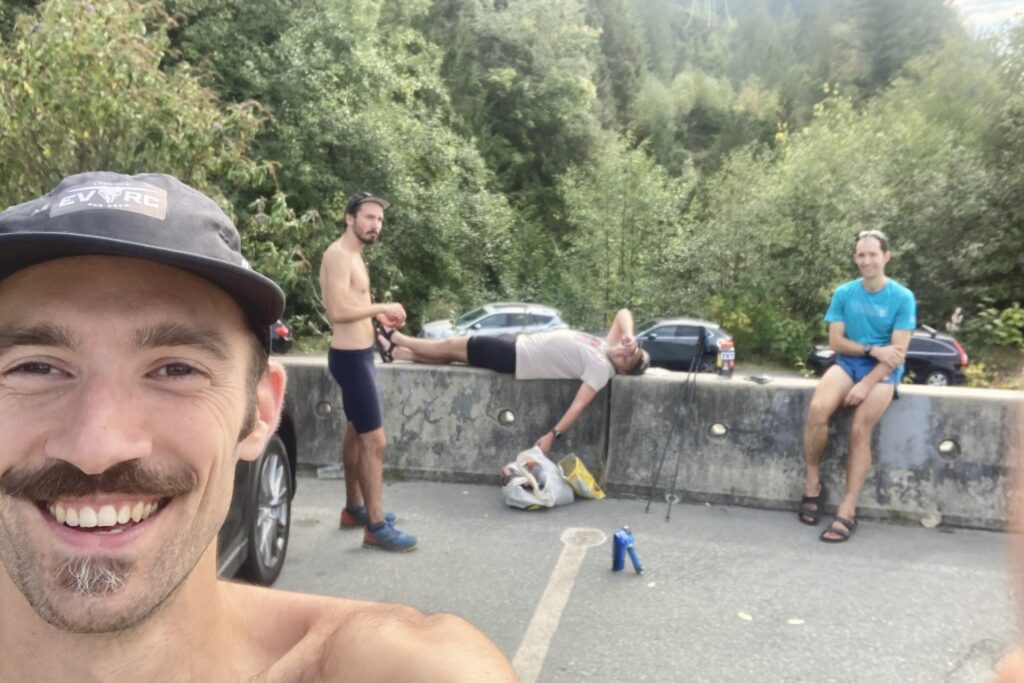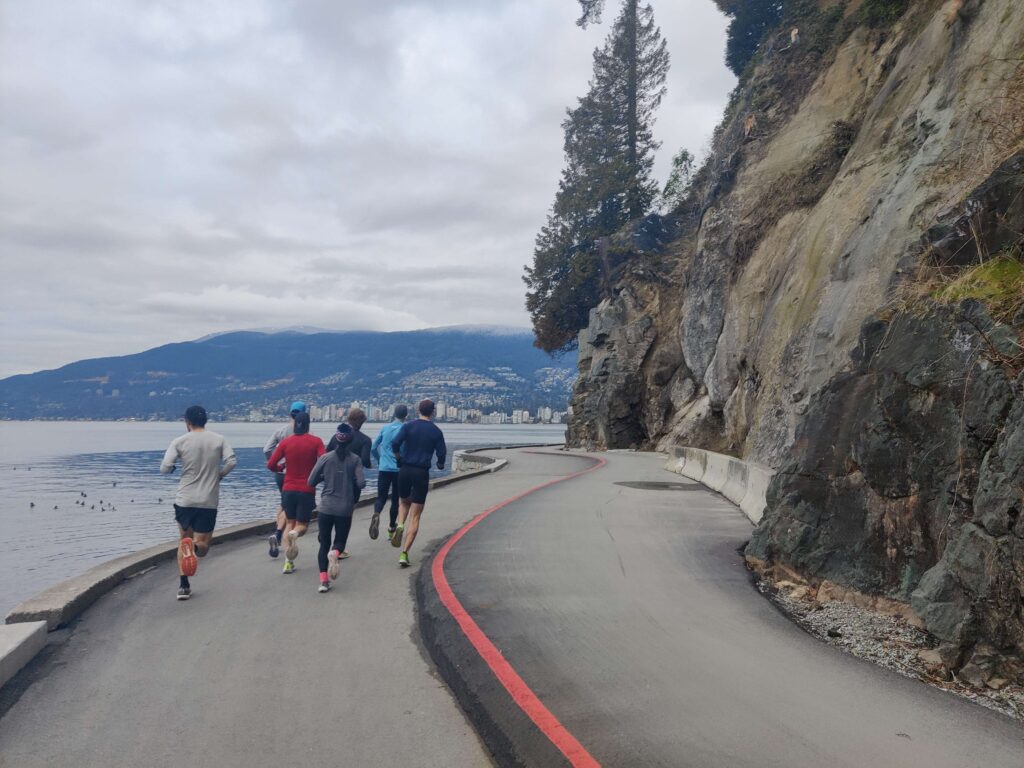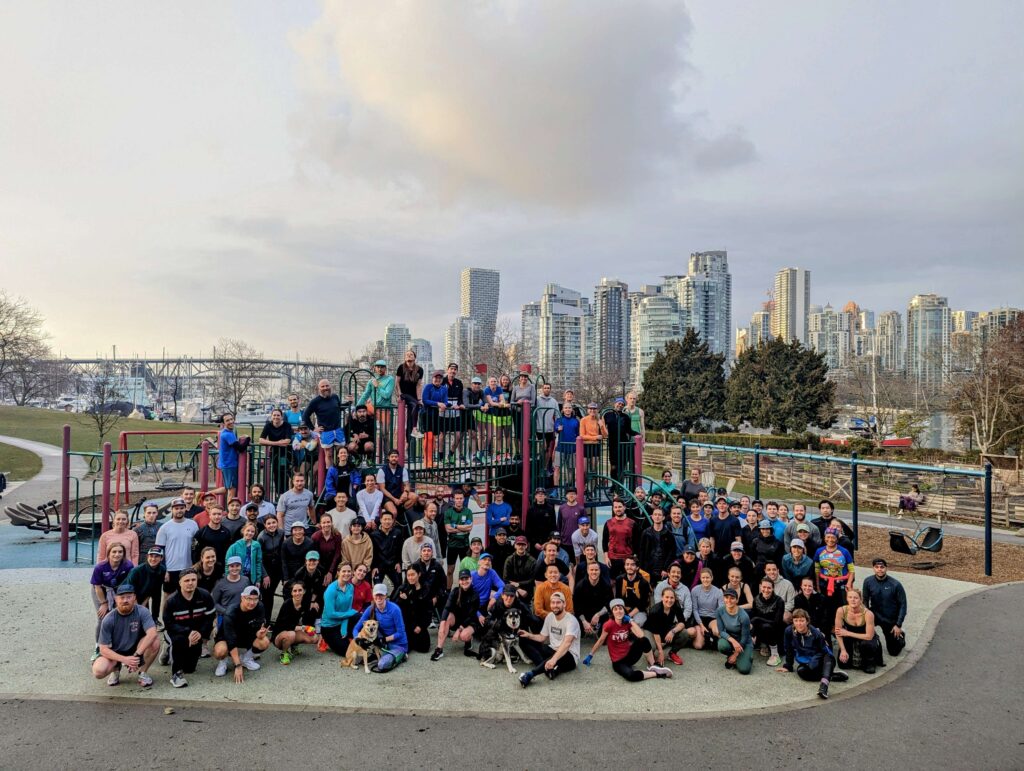Marathoning and The Process
“So, what do you do for work?”
It’s the universal go-to phrase for small talk. The one we all reach for occasionally when we’re next to a stranger and aren’t quite sure what to say. I’ve had plenty of practice answering that question at parties and on first dates, but it caught me off guard in the middle of a marathon.
I was running the Royal Victoria Marathon, a short ferry ride across the Strait of Georgia from my hometown of Vancouver, and a local runner named Jackson was making small talk as we made our way along the coast towards Oak Bay. We were going to be each other’s only company for the better part of two hours, and I guess he figured we may as well get to know each other a little bit.
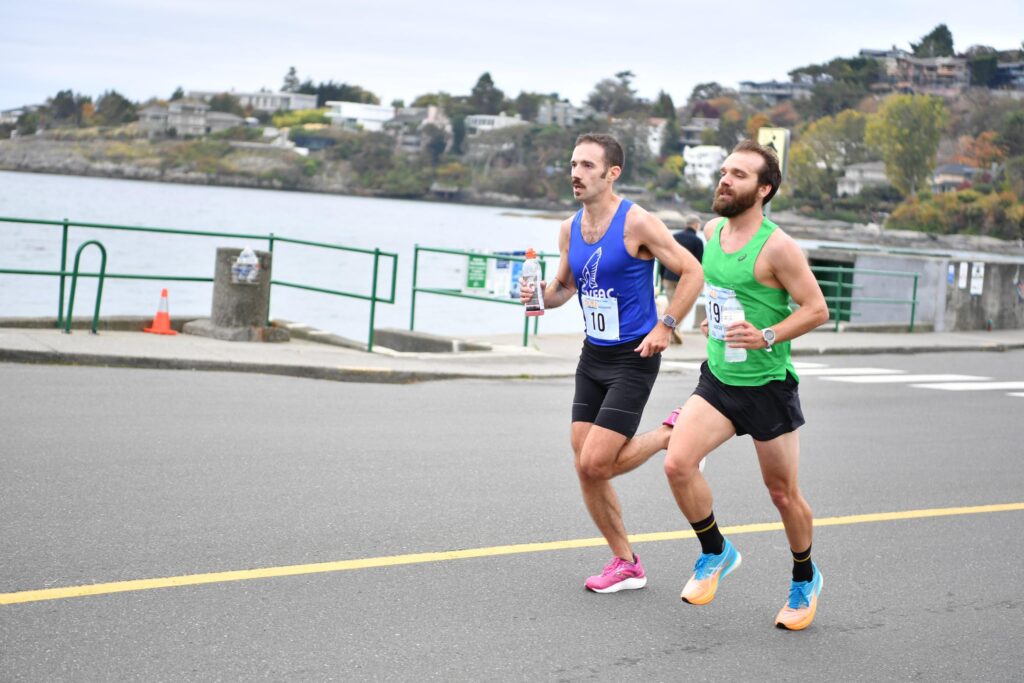
We were coming up on the halfway mark of the race, and I was on track to come through only a few seconds off my best time for the half-marathon distance, set back in 2020. I remembered how, in the last kilometre of that half-marathon, I felt so bad that I had to stop and puke a little on the side of the road. But this morning, about three and a half years later, I surprised even myself that I was making idle chit chat at that same pace, and still had over 21 kilometres to go to the finish.
Unlike other hobbies we pursue throughout our lives like speaking Spanish, baking cakes, or playing the guitar, our progress as runners is constantly being measured. The watches we wear on our wrists every day tell us how much better or worse we are than this time last year, down to the second (or hundredth of a second). That can be a cruel thing when we’re having a bad day, and the timer can’t help but rub it in our faces.
But on the other side of the coin, most runners who’ve been in the sport long enough have had a breakthrough moment like I was having at the halfway of this marathon. Moments where we realize, after so many years of training, that we can run for hours at paces that used to leave us gasping for air.
I think the best part about these kinds of running breakthroughs is the satisfaction that comes with reflecting on just how much hard work we put into getting there. Improvements as a runner can’t be bought, sold, or faked. The only way to get faster is by logging all those hours pounding the pavement. And it’s that sense of honest, earned pride in our training that makes success in races feel so sweet when it does eventually come.
I was hoping that everything was going to come together for me on that perfect October morning in Victoria on the Sunday of Thanksgiving weekend. The sun was shining on the yellow leaves of the trees that lined the marathon route, and a breeze blew in off the ocean to keep us cool. By any measure, it was a perfect day to run a marathon, but my first feelings of doubt in my pace and race tactics started to set in with each of the many hills through the middle section of the route. The course generally went out and back along the coast of Vancouver Island, and Jackson and I made our way up and down the hilly road out towards the turnaround point in second and third places. The race leader was a couple of minutes ahead of us battling demons on his own, having created a big enough gap for me to write off the chance of catching him.
We soaked in the energy of the cheering schoolchildren, giving up their precious Sunday mornings to hand out cups of water as we cruised past. I was surprised at how many people had shown up to sit or stand on the side of the road to yell encouragement given that we were in a sprawling residential area. As we ran by the long driveways and towering gates that led to the mansions of the Uplands neighbourhood, I had enough energy to make a joke complaining about the “shitty neighbourhood”. It was a reflex after years of making that same joke every time my training group ran in the upscale neighbourhoods of Shaughnessy or Point Grey in my hometown.
But the joke was a way to hide my growing worry about the pace. When we turned around at the 25-kilometre mark to start heading back towards the finish, the difficulty of the task of me ahead set in, and a wave of fatigue fell over my body when I tried to imagine running this pace all the way back to downtown Victoria. The pace that had felt so manageable just 20 minutes ago suddenly felt like a slog when I tried to imagine keeping it up for another 17 kilometres. My competitor was a few strides ahead of me within a moment and I felt the whole thing start to unravel.
The rest of this marathon was going to be pretty grim business.
Earlier this spring, I was dealing with a mysterious leg injury that kept me away from running for over a month. As any runner can tell you about that situation, it’s a bummer. All your racing plans and dreams of personal bests and new achievements for the season go out the window. The goals you set for yourself at the beginning of the year, and for which you worked so hard up to the injury, start to evaporate.
But the thing that any runner who’s been hurt or sick will tell you is that missing out on the chance at glory in races is the easiest thing to get over. Despite how much time and energy we put into getting ready for our silly little competitions, it turns out that forgetting about them is actually the most trivial part of being hurt.
The thing that really makes us sad when we’re injured is the inability to get out there and just run. We miss getting some fresh air and decompressing with an easy 10 after a hard day at work. We miss meeting up with our training partners at the track for an epic session followed by cold beers. We miss having a reason to get up at dawn and cruise the Seawall at a good clipbefore the rest of the city wakes up. We miss the silly banter and raw emotion that really seems to come out in conversation after 30 kilometres with close friends.
When I was hurt and missing out on all that fun stuff, I was filling up some of my spare time learning about the sport. One of the pieces of advice I was finding coming up over and over had to do with setting “process-oriented goals”. Bright minds like author Steve Magness and national champion collegiate and professional coach Mike Smith were preaching in books and podcasts to stop focusing on the outcomes I wanted to achieve – because those are largely out of my control – and instead set goals around how I wanted to practice this sport (and more generally, live my life) on a day-to-day basis.
That stuff really resonated with me as I was at home missing out on all that running. And I made some promises to myself that I wouldn’t take my track workouts, group long runs, or solo sunset jaunts for granted again. I wouldn’t fail to realize that the “good old days” were happening when I was right in the middle of them. The goal wasn’t to win the race or set a record. The goal was to get outside and run every day, work hard, and share the joy and satisfaction in the process with the people around me.
I was pleased to bounce back from the injury relatively quickly and put in a few months of solid training through the late spring and summer. For the first time in my life, I was often running twice a day, and even cracked 100 miles of running per week a couple of times. It was the type of running I had dreamt of doing ever since I was kid competing in cross country and reading books about the epic training schedules of my running heroes. And I was having a blast, too.
I had never really trained through the summer before, opting in past years to spend my time and energy during the sunny months on hiking, camping, and sitting in parks drinking beer. This year, I learned to enjoy the routine of getting out for sweaty jaunts in the hot afternoons, just as the little portable A/C unit in the apartment and home office I shared with my partner failed to keep us even a few degrees below “sweltering”. I loved how fast and free I felt running loops around False Creek in just my shorts, almost as much as I loved the taste of cold lemonade as soon as I got home. I realized what a joy it was to get all my training done during daylight hours, decidedly better than running by headlamp through one dark rainy evening after another in the fall and winter.
Monday evenings I joined the East Van Run Crew to cruise through the alleys and local roads of my neighbourhood and then hang out in the park and watch the sun go down. Wednesday evenings my training partners with the Vancouver Falcons Athletic Club and I crushed track repeats before heading to the pub to devour burgers or nachos. Saturday morning, I was at it again with the Falcons, usually round and round the forested trails or seaside paths of Stanley Park before the tourists and beachgoers descended on the area. Sunday morning, I didn’t mind at all my alarm waking me up early to meet up with the crew that was quickly becoming my closest group of friends for a long run of 20, 30, and sometimes close to 40 kilometres all around town. And between all the group sessions, I was fitting in easy runs of my own whenever I could find the time before work or even on my lunch break.
The schedule was pretty rigid, the bedtimes were often early, and I found that it was actually a great way to spend a summer. Just like I set out to do in the spring when I was coming back from that injury, I was proud of how much I was getting out to run every week, satisfied with how the daily run made my body and mind feel, and stoked to do it in a way that built community and formed a bond with the people around me. When I finally made it to Thanksgiving and the end of my marathon build, I knew that whatever happened out on the course in Victoria, I had accomplished my goals and the whole endeavour was a success.
Nervous energy and stomach butterflies can be a good thing for runners lining up for a race. All that stoke and adrenaline is what allows us to run far faster in competition than we ever could in training. But too much nervousness can ruin an athlete’s race before it even begins. In the past, I’ve shown up to races that I fretted about so much in the preceding hours and days—running the thing over and over in my head—that by the time the gun went off, I had nothing left when it counted. The key is reigning in the emotions in until you need them.
So, when my alarm went off well before sunrise on the morning of Victoria, I relaxed into the familiar pre-race routines. Breakfast was the same as always: toast with jam and a cup of coffee three hours before the start. Three other runners from my club named Mel, Conrad, and Kat, my partner Kalysha (who not only patiently tolerated my running habit through the summer, but also travelled to the Island to support me), and I were renting a house for the weekend, and it was a treat to sit around the kitchen table enjoy each other’s company as we got ready together.
I put on my club’s racing singlet and fastest pair of shorts and shoes, then wrote my name on the four bottles of pink lemonade that would fuel me through the marathon. The group of us drove into downtown Victoria, parked, and converged on the start area with thousands of others coming in from every direction as the sun started to rise. I let the nervous energy bubbling up in my head rise to low murmur as the crowd of runners grew thicker around the historic Parliament Buildings
I said goodbye to my housemates for the weekend as they found their own places in the start corral, and to my partner as she made her way to a good spot near the start to watch and cheer. After finding the start line, using the porta potty, and dropping off my bottles with the truck that would place them along the course at various points for me to pick up, I settled into the familiar warm-up rituals. Ten minutes of jogging, five minutes a little quicker, drills, strides, off with the sweatshirt and pants, and then more strides until we were called to the line. The nervous energy was spreading now like electricity out to my hands and feet and I didn’t mind it building as I got moving and it all finally had a place to go.
The start area was filled other runners moving through their own warm-up routines, and I was happy to spot a few familiar faces. I jogged a few minutes with Mark, a runner who had always seemed to finish within seconds of me in races the last few years. I chit-chatted with Kyle, another Falcon with whom I had shared countless workout reps and long runs, as we did drills next to each other. And I even strided past Cam Levins, the fastest North American marathoner of all time. His gait was so smooth that he didn’t necessarily look faster than everyone else, but when he passed me, I felt a gust of wind kind of like the one you feel when a semi truck goes by on the freeway.
The half marathon was starting at the same time as the marathon, which meant that most of these folks weren’t even my competitors. I kept my eye out for the white bibs that identified the marathoners, trying to size up the competition without really knowing what to look for. Everyone looked fit as hell.
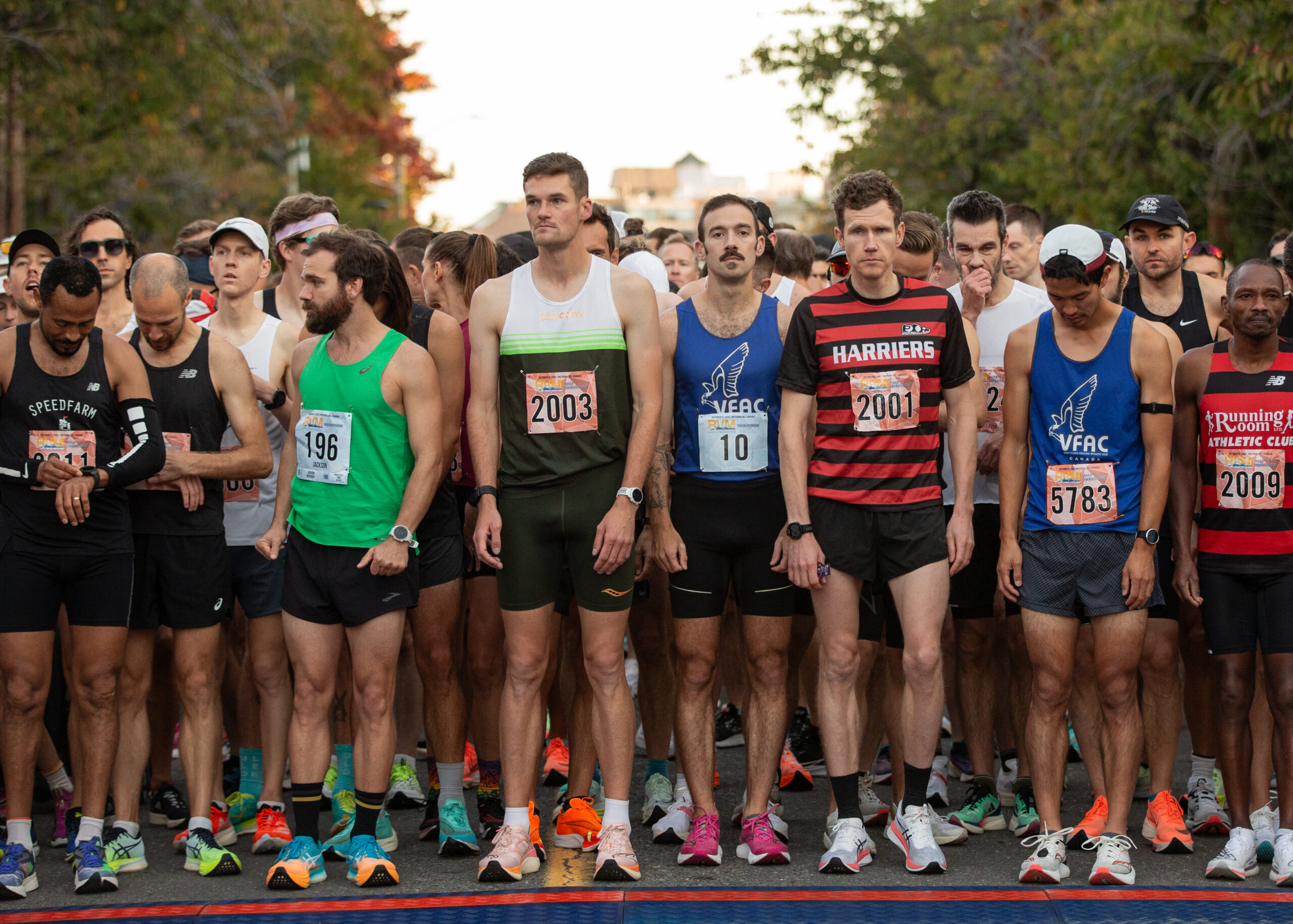
“Five minutes to go! All runners make your way to the start line!” My heart almost leapt out of my chest as I realized that I had finally run out of time to prepare for this race. The only thing left to do was actually run it. I lined up in the second row of bodies, conscious of not wanting to get caught up with the elite half-marathoners. Now that I was stuck in the mass of runners, the nerves built to a crescendo that pulsed throughout my body. When it got like this, I knew I was either going to throw up or have the run of my life, and I could only hope for the latter. It was some comfort having Kyle lined up right next to me, feeling just a little like the start of every Saturday and Wednesday workout this year.
“10 seconds to go!” We all turned on our watches, took a final deep breath, and waited until the Crack of the gun sent us off like a surge of water making its way through the city. The route snaked around the Parliament Buildings, past the harbour and then through the city centre. The fastest half-marathoners shot ahead right away, and I watched two guys in marathon bibs ambitiously build a gap ahead of me. I let them go instead of getting caught up, all too familiar with how that nervous energy and adrenaline I had been building up at the start can dull the perception of effort and make a runner go out way quicker than planned.
I figured that if I had a perfect day I might average 3:25 per kilometre over the course of the race. So it was a relief when we went past the 1 km marker and I looked down at my watch to see that I was pretty well right on track. I even said the split out loud “3:21 that’s perfect” to the runners around me, although I was mostly saying it to reassure myself that things were going according to plan. I had settled into a relaxed rhythm with about eight other runners—all half marathoners—many of whom I had run with before. I felt right at home running next to my current training partner Kyle, a past clubmate and training partner named Johnathan, a handful of guys I recognized from the local road running circuit, and a couple of unknowns.
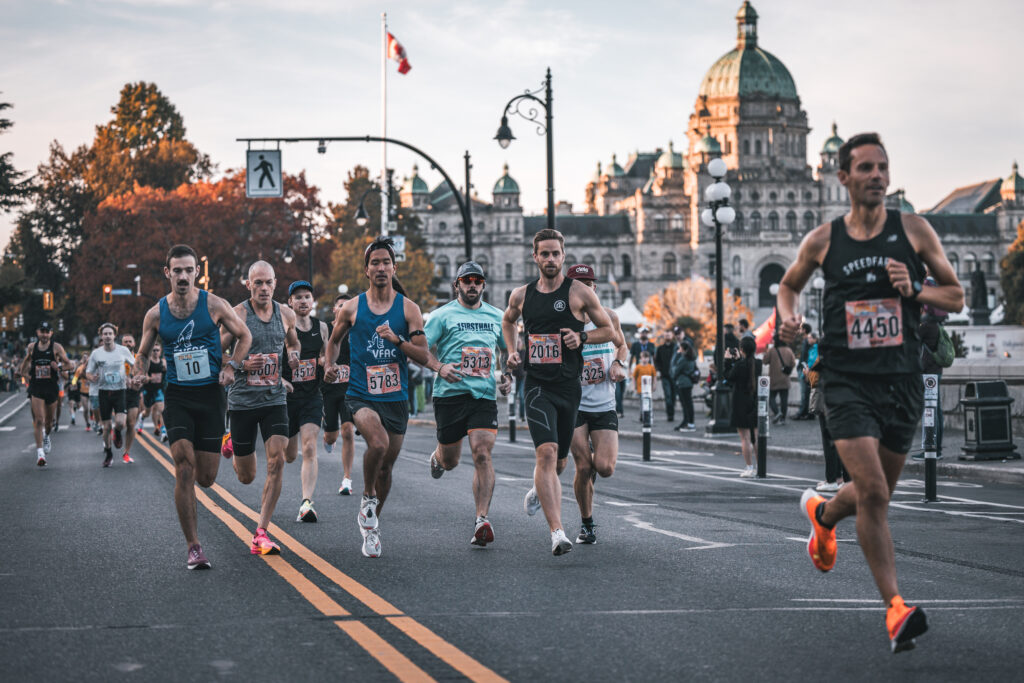
We cruised through the first couple kilometres in the city centre with the satisfying early-race effortlessness that comes after months of preparation and a couple weeks of rest leading up to the race. The rolling hills of the Victoria Marathon that would challenge me later in the race felt very manageable on fresh legs. I relaxed on the uphills, sometimes even falling behind my group, but gained ground on the downhills where the cost was less. That was a neat trick I learned years ago from my coach at the time, John, and it had served me well in a lot of races.
Around the 6-kilometre mark of the race, we passed through the forested Beacon Hill Park, where a steady crowd of spectators had showed up to cheer us on, likely having walked over from the start area. Among them was Kalysha, and hearing her support as I ran by gave me another boost of confidence.
At the south end of the park, we emerged from the greenery onto Dallas Road and got our first view of the Strait of Georgia. The morning light was shining over the water’s surface all in gold and it was still early enough in the race for me to notice how beautiful it was. Our first aid station was at 9 kilometres where I spotted and grabbed the bottle of lemonade with my name on it without issue, pleased that I had practiced the routine over and over in workouts. The one thing I was unprepared for was the uncertainty of what to do with the empty bottle once I was done; I said a silent prayer and apology to whoever I was supposed to and chucked it to the side of the road a little guiltily.
The handful of guys I had been running with since the first kilometre was still largely together and I was stoked to stay locked into our rhythm. By that point, we had even absorbed a couple of the overzealous folks who went out quick from the gun and found themselves running solo, including one of my competitors in the marathon. The collective energy that comes out of group of runners moving at pace in unison is contagious, and it felt like I was being carried along.
Unfortunately, that rhythm I enjoyed so much was going to be thrown off soon, as the marathoners split off from the half-marathoners at the 13-kilometre mark. At that point, I would head east further and further from the finish line, while the lucky guys running the half would feel the sweet relief of turning around to head back. As we approached the split point, the marathoner we picked up—a local with experience on this course—was cool enough to let me know that I should probably get unstuck from the pack and get ready to turn left as everyone else was heading right up ahead.
And when the split finally happened, it was like someone had sucked all the energy right out of the race. In a moment, we went from eight runners down to just two, and it no longer felt like I was being carried along. It dawned on me pretty quickly how much more focus and introspection I would need from now on to get through this thing.
As far as I could tell, my competitor seemed unbothered by the transition. He clearly knew every turn in the course and had done this marathoning business plenty more than me. He surprised me after just a few minutes of running together with the question “So, what do you do for work?”
If you hang around a group of runners long enough, you’ll find that the topic of conversation will inevitably—as if by some gravitational pull—land on that of upcoming races. It’s the small talk of choice for people that might be bored of their jobs, out of touch with the latest tv shows, but are plenty invested in their hobby. And they’re genuinely interested to know what you’re training for, how your running’s going, and what your goals for the race might be. Everyone’s always keen to know if you’re shooting for a given time, a new personal best, or an age-group record.
Most runners with an upcoming race have a goal that they’re willing to share, and a loftier goal that they keep to themselves until finding out if it’s possible. A goal that they dream of achieving when their minds wander in the middle of workouts but are a little embarrassed to say out loud.
When I signed up for the Victoria Marathon and spent some time researching both the results of previous years and the resumes of the other guys on the start list for 2023, I figured I had a small chance of winning the whole thing. It would be dishonest to say that the idea didn’t get me fired up, but I tried not to get to attached, knowing the stars would really have to align for it to happen, and after all, I was setting goals related to my process this year, not goals attached to outcomes.
So, in the months leading up to Victoria, when my training partners and running friends would ask me if there was a time or placing I was shooting for in the marathon, I would usually say something about how I just wanted to “be competitive out there” or “really just see what I was capable of”, or another similarly non-committal cliche. Because although I did occasionally daydream about breaking the tape and finishing first, I knew that was less important then just doing my best in the race and the preparation, and I wanted my friends to have the same idea.
On one of the hundreds of training runs I did this year on the Stanley Park Seawall—the scenic waterfront path in Vancouver that’s jammed every day of the summer with a mix of gawking tourists, parents with strollers, and runners like me—I was cruising along with my clubmate Kyle and talking to him about the concept of process-oriented goals as we watched the sun set over English Bay.
Turns out he was already hip to the idea, having learned about it in books and on social media just like me. We were right on the same page as we agreed that the best part of a good race result isn’t the time itself, but the dozens of nights at the track and early mornings in the park with friends leading up to the event. As we got nostalgic about the thousands of kilometres we shared over the years, Kyle summarized the whole concept neatly.
“Maybe the real personal bests were the friends we made along the way?”
We’re back at the 25-kilometre mark of the Victoria Marathon, and if you remember, things are suddenly not going well. The way the course was relentlessly undulating with what seemed like no flat spots to catch my breath had started to wear me down, and I just couldn’t imagine how I could keep it up all the way back to the finish at the Legislature, which seemed a world away at this point.
My pace started to lag and the gap between me and my competitor Jackson started to grow and grow. It felt like the metaphorical elastic band that had joined us for the last 15 kilometres or so had snapped and I couldn’t will myself to keep up. Spectators lined the streets and cheered just as earnestly as they had earlier in the race, and as much as I appreciated the enthusiasm they were sending my way, I started wishing that they would just leave me alone to suffer in private.
The hills were bigger and steeper than I remembered them being on the way out, and my legs felt heavier and heavier with each one. I didn’t do enough marathon-pace work in training! I hadn’t done any 40-kilometre runs! What was I thinking trying to run this fast for a whole marathon?
I accepted it as a given that I would eventually have to stop and walk at some point. There was no way I could run all the way to the end feeling like this. My shoulders ached and my stomach started to turn and fatigue crept all the way down my legs. This early in the race, I wanted to be floating along easily, but I found myself needing to focus just to keep my stride together. The idea that I would eventually just give up and walk was actually comforting: at least I wouldn’t have to feel like this anymore.
And then I noticed it.
The gap between me and Jackson had stopped growing. As bad as I felt, I was actually reeling him in. An instinctive jolt of energy shot through my system and suddenly I was chasing him down. The fatigue was still there in my legs, but now I had the drive to push through it.
As I came up on his shoulder, Jackson was practically limping. I knew right away that he wasn’t coming with me. “Really bad calf cramps, man.” And then he motioned to the flashing lights of the pace car that indicated where the leading runner would be, a few hundred meters ahead. “Go get ‘em!”
We had barely known each other an hour but I felt genuine sadness for how quickly this practical stranger’s run was unravelling. One thing about this kind of running is how it breaks down the emotional barriers we spend so much of our energy keeping up in day-to-day life. I said something that was supposed to cheer him on that you say to runners in the middle of a race, even if you know they’re beyond hearing it.
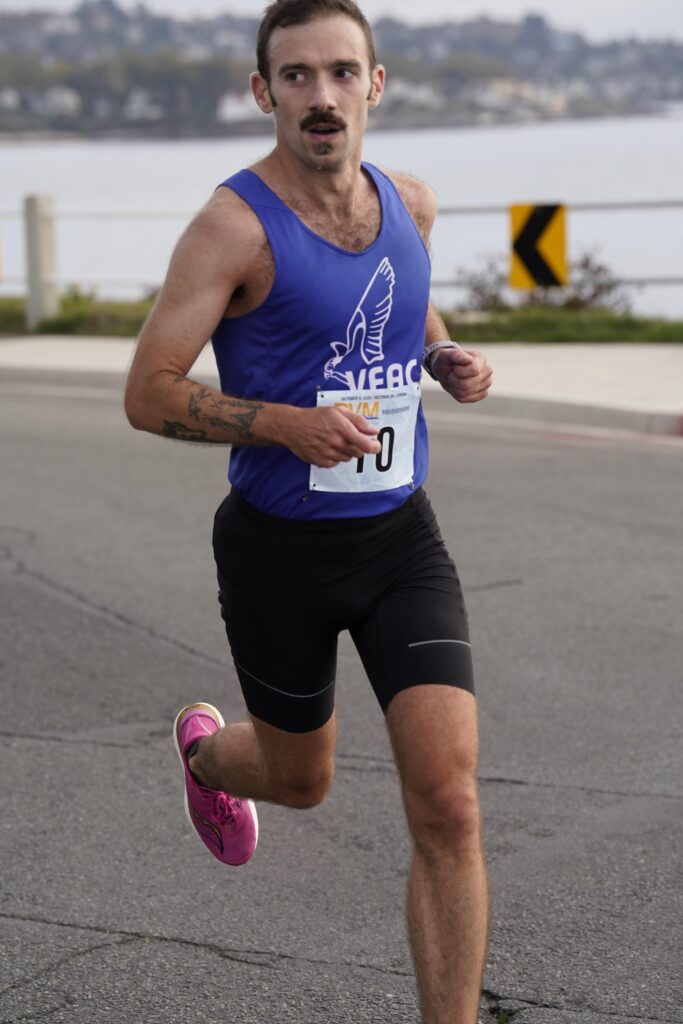
I moved into second place and was feeling fired up. At this point, there was a steady stream of runners on the other side of the road coming towards me on their way out to the turnaround. I was amazed many of them took energy out of their own races to encourage me, including a few familiar faces from Vancouver, and I did my best to manage a smile and a thumbs up.
At the 31 kilometre aid station, it was a chore to finish my lemonade. The sickly sweet taste was no longer appealing and I could feel it sitting in my gut. After a couple minutes of trying to get it down, I looked at the remaining liquid, thought briefly about the spreadsheet I had used to calculate the exact amount of to measure out and painstakingly put in each bottle for optimal performance, and chucked it to the side of road.
The course left the coast for a few kilometres, winding its way through the residential areas of the District of Oak Bay. The route turned so many times that I lost my bearings. In my depleted state, I’m not sure I could have made it back to downtown Victoria without the traffic cones marking the way and volunteers at every corner making sure I didn’t wander off.
I had caught the tail end of the half-marathoners, and having groups of runners around me again was invigorating. I couldn’t see my competitor up ahead, but the way that spectators were urging me on made me think that he wasn’t too far away. I tried to find a rhythm and concentrate on closing the gap, but all the twists and turns and incessant rolling hills made it impossible to lock into any kind of flow. A major incline around the 35-kilometre marker took the wind right out of my sails as the course brought me back along the ocean, and there was nothing I could do to keep from slowing down.
While the setback I had faced earlier on near the turnaround of the race was pretty much psychological, the fatigue that was setting in now wasn’t something that could be overcome with willpower. The sugar stored in my body was burned up, and now I was running on fumes. I was pleased to have got past the point of feeling like giving up, but I still couldn’t imagine how I could possibly make it to the finish line. So instead, I focused on a more manageable goal. I knew my last bottle was waiting for me at 37 kilometres, and I decided that I just needed to make it there for now.
When earlier in the race the kilometres had flown by and my stride was effortless, I now felt like I needed to remind myself how to run every hundred metres. Relax the shoulders. Kick up your heels. Drive your knees. The systems just weren’t firing on their own anymore. I stopped looking at the pace shown on my GPS watch. I knew it was getting slower and I knew there wasn’t anything I could do about it.
From the top of the hill, I could see the final aid station below, and I could see the pace car and lead runner. They looked impossibly far ahead. The long downhill stretch that carried me to my final bottle of lemonade was a relief, and I managed to drink nearly all of it, knowing that I needed whatever help I could get from the fuel.
The next goal in my mind was 39 kilometres, where I knew Kalysha would be waiting for me. I had run 2 kilometre repetitions countless times in training (often much faster than I was currently going) but now I couldn’t bear to think about running any more than that at once.
A familiar mantra wormed its way into my head. This is the hardest thing you’ll do all week. Sometimes, when my running workouts and races start to feel impossible, I’ll reflect on just how comfortable my middle-class urban life is, and that if this absurd hobby I participate in voluntarily is the toughest thing I have to get through in a given week, how could I phone it in and still feel good about myself?
I crested another hill in the scenic Beacon Hill Park, the last real challenge of the course, as we approached the 39-kilometre marker, and I was stoked to see not only Kalysha, but my cousin and uncle who had apparently driven in from their home in the next town to see me run, and a few of my training partners who had already finished up the half-marathon. They cheered me on and told me how bad the lead runner looked like he was hurting, and I set off to tackle the last section of the course through downtown with renewed energy from seeing so many of my loved ones.
Don’t get me wrong, I was hurting and in a bad way, but now I could feel the finish line. There were no more milestones between me and the end, and there was nothing left to do other than just get this thing done. I was running scared of my competitors behind me, conscious of how much my pace had slowed in the latter stages of the race. The course looped around the Victoria harbour until I finally felt that we were heading east towards the finish.
By now I knew that I wasn’t going to be able to take the lead, the pace car nowhere in sight, but the fear of being caught and passed was what allowed me to squeeze out every last ounce of energy left in my system just to keep moving. Kevin, my coach, was on the side of the road with about a kilometre to go urging me on, just like he had at every workout for the last year. By now, the street was crowded with half marathoners, and I weaved through them as the noise of the finish line grew in the distance.
I was beyond exhausted, every muscle in my body sore from exertion, but the signs indicating how much distance was left to the end gave me something tangible to hold on to and keep pushing. 800 metres to go: Just half a mile. 400 metres to go. Just one more lap of a track.
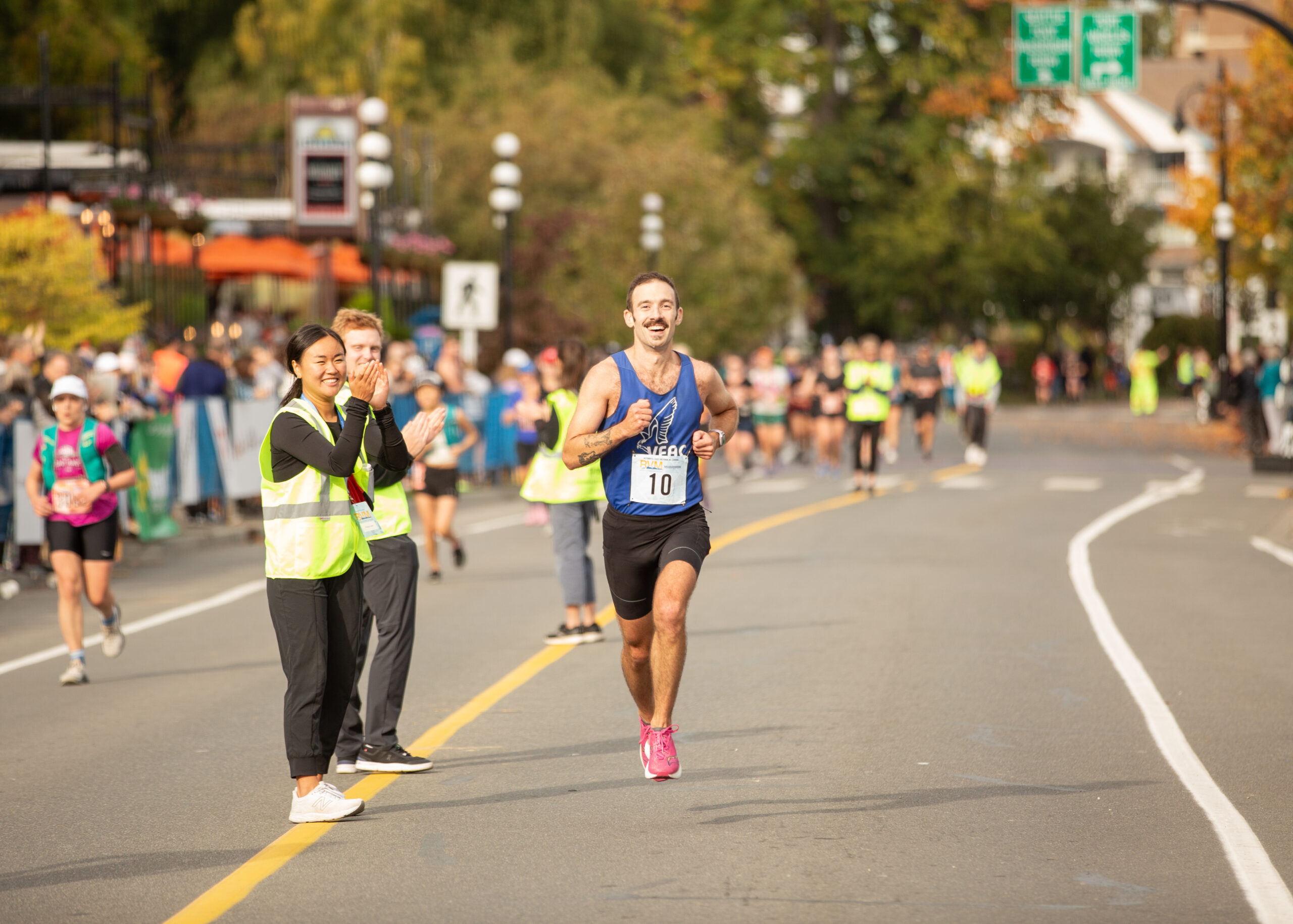
I turned right one final time onto Belleville Street and the arch over the finish line was in sight. The roadway was lined with people and my fatigue gave way to elation as I soaked in the sights and sounds. I could hear the announcer calling my name and I lifted my arms in celebration. “He looks like he’s pleased with that!” I heard over the loudspeaker, and I really was. I glanced at the clock as I came through—2:30:16—I had trouble understanding what those numbers meant and if I was supposed to be happy about them, but people around me were cheering and a volunteer handed me a medal and I certainly felt happy. I shook the winner’s hand and waited for Jackson to come in about a minute behind me to congratulate him, too.
I was guided and ushered through the finish area and stopped to chat with some of my clubmates offering their congratulations through the fencing that lined the side of the road. I wanted to ask them just how the half-marathon had gone anyway, but there was always another volunteer telling me I couldn’t stand here and needed to keep moving.
I limped out of the chute and was thrilled to find Kalysha, my cousin, and uncle waiting for me. After the sweaty hugs and keepsake photos they asked me if I wanted to sit, wanted a clean shirt, wanted to eat something. I honestly told them I didn’t know, I don’t think I wanted or needed anything.
I stood on the lawn of the Parliament Buildings in the crowd of happy runners and their loved ones and felt just fine.

